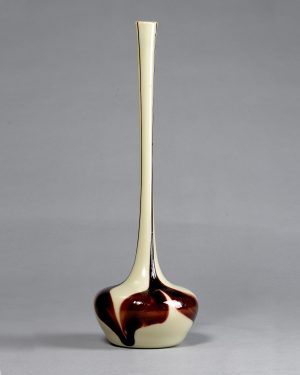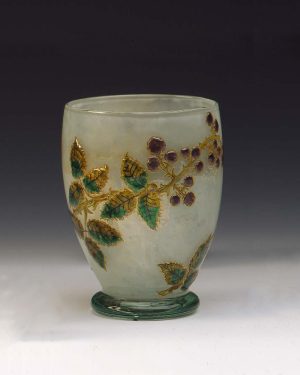“CARP” VASE, BEFORE 1885
Quadrangular shape, transparent blown-molded glass with crackling and interspersed red and
green inclusions
Decoration of a Japanese carp leaping through foam
Unsigned
Height: 30 cm
The unsigned pieces are by Eugène Rousseau. Léveillé continued to produce this model in thinner glass.
Exhibition
Union Centrale des Arts Décoratifs, Paris, 1884
Bibliography
Revue des Arts Décoratifs, 1884-1885, rep. p. 194a.
Glas des Art Nouveau, Die Sammlung Gerda Koepf in Kunstmuseum Düsseldorf, éditions München, New York, similar vase ill. p. 27
Siegfried Wichmann, Art Nouveau floral, éditions Chêne, Paris, 1896, ill. p. 103
1889 Exposition universelle.
« Les colorations produites par les oxydes métalliques sont très variées, sans que pour cela aucune nuance nouvelle soit obtenue ; les améliorations consistent plutôt dans la façon dont ces teintes de verre ont été harmonisées et dans la façon dont elles ont été introduites, appliquées. On a pu, en effet, produire des effets nouveaux par la dissémination de verres pulvérisés, de diverses grosseurs et de diverses teintes, dans l’épaisseur de la pièce de verre, d’après le mode de décoration imaginé par M. Rousseau dès 1884 (exposition des arts décoratifs), ce qui permet d’imiter les pierres gemmes que l’on trouve dans la nature, sous les formes les plus variées et les plus brillantes.
Employé avec discernement, avec discrétion, ce mode de décoration produit des effets remarquables jusqu’au moment où l’introduction trop considérable de verres opaques finit par détruire la transparence du verre. Des tailles plus ou moins profondes, décorées d’émaux, ou dorées après coup, complètent ce décor quelquefois un peu excessif.
M. Rousseau-Léveillé s’est attaché également à perfectionner les formes et la matière des cristaux de luxe. Quelques-unes de ces pièces aux profils élégants et aux riches montures d’or et d’argent, sont de véritables œuvres d’art qui méritent d’être signalées.
Dès 1867, M. Rousseau a commencé à faire fabriquer d’après ses dessins, ses modèles, d’après ses indications, des verres de couleur et des pièces de fantaisie en deux tons non superposés, mais soudés l’un à l’autre, avec lesquels il obtenait des effets absolument nouveaux, « neutres », des pièces de verre dont la partie supérieure était en verre de couleur tombant en goutte sur le neutre.
Ensuite vinrent les pièces colorées avec des reliefs apparents, mais de couleur différente du fond, puis vinrent les imitations de pierres dures, agate, jade, strass.
Une pièce, remarquée en 1878, fut créée par Rousseau, qui figurait encore cette année à l’exposition de M. Boucheron, pièce de strass de grande dimension qui fut considérée en 1878 comme un véritable tour de force.
Le succès de Rousseau fut éclatant à l’Exposition des Arts décoratifs de 1884 ; c’est là, si nos souvenirs sont exacts, que figurèrent pour la première fois des verres « craquelés » intérieurement. Ces craquelures donnaient aux objets de verrerie une originalité et une puissance de réfraction qui furent très remarquées.
En 1885, la maison Rousseau devint la maison Rousseau-Léveillé. M. Léveillé, guidé par M. Rousseau et s’inspirant des idées de son prédécesseur, continue la tradition artistique de cette maison et fabrique des imitations de sardoine, de jade, d’agate, d’améthyste avec application d’oxyde et d’émaux colorants, soit en relief, soit dans le corps des pièces.
S’inspirant de l’art japonais, M. Léveillé-Rousseau, par l’emploi des acides combinés avec la molette du graveur, est arrivé à présenter à l’Exposition de 1889 certaines pièces originales qui montrent le parti qu’on peut tirer de l’assemblage des différentes espèces de verre travaillées après coup. Ainsi, par exemple, je puis citer ici un grand vase avec poissons qui est en verre neutre avec des colorations d’oxyde d’urane et de cuivre à l’intérieur ; cette doublure a été retournée deux fois sur elle-même, afin de permettre à la gravure de produire des tons différents. Cette pièce, de grande dimension, représente beaucoup de difficultés vaincues en raison des bouillons renfermés entre la pièce et la couverte.
Les agates saupoudrées d’oxyde de cuivre sur lesquelles on a appliqué des colorations jaunes ont permis d’obtenir des vases qui ont été gravés d’abord à l’acide et ensuite à la roue, en laissant le fond mat et les reliefs brillants.
Les pièces en imitation de sardoines foncées, taillées à rinceaux avec colorations extérieures, sont à remarquer, puis aussi des agates avec bord râpé, une coupe couleur fleur de pêcher et un vase méplat avec tête renaissance posée sur feuille d’or.
Ces objets, nouveaux comme décorations, indiquent que cet art peut encore se développer, « s’affiner » en donnant au verre toute sa valeur comme forme, comme coloration, en arrivant à supprimer complètement la décoration extérieure, – or ou émail, – cela en combinant les colorations, les graduant et en laissant au verre toute sa transparence, ce qui est sa qualité essentielle ». Jules Henrivaux, La verrerie à l’Exposition universelle de 1889, Revue des Arts Décoratifs, 10ème année, 1889-1890, pp. 171 à 173.
































